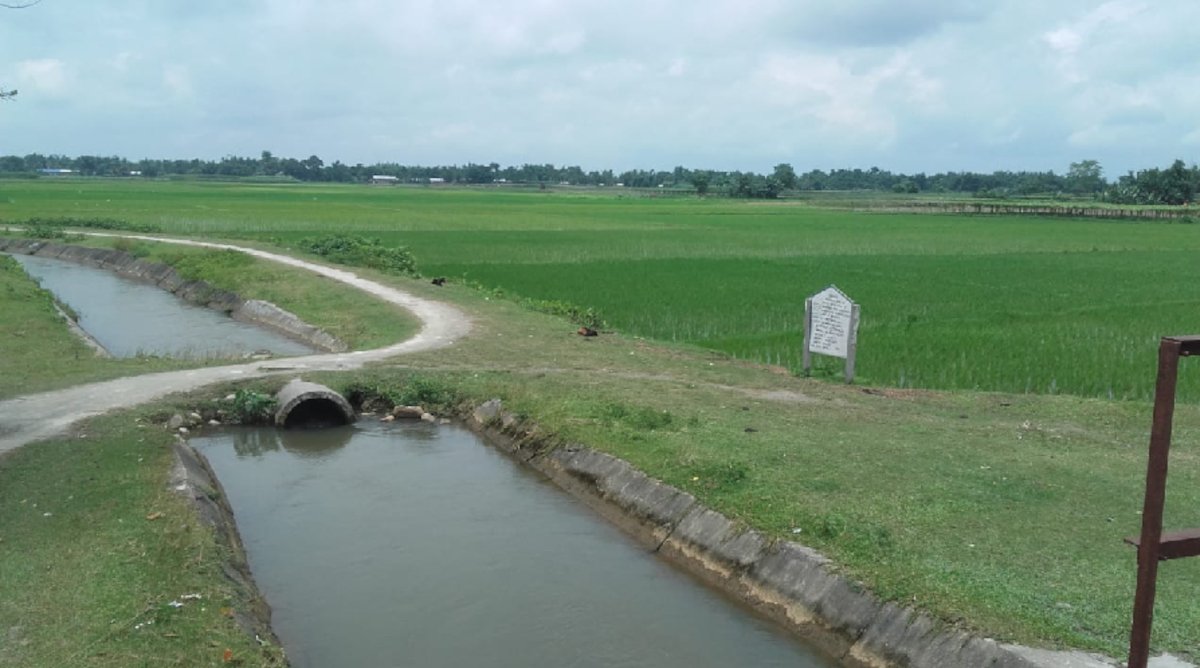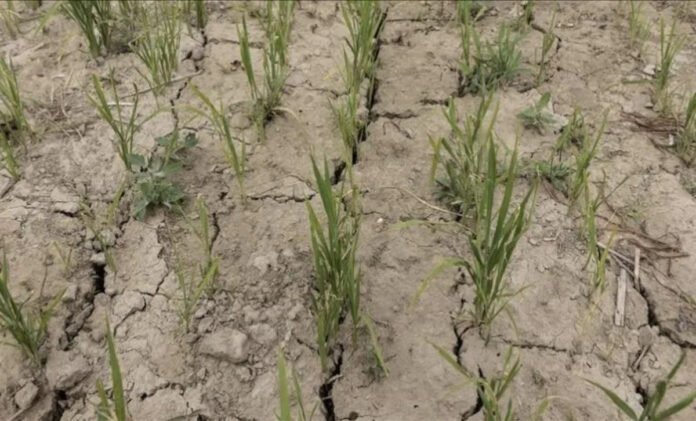In the face of mounting climatic uncertainties, five districts in Assam—Kokrajhar, Barpeta, Dhubri, Baksa and Bongaigaon—have been officially declared as drought-hit by the State government in July. A prolonged rainfall deficit, reported to be over 40 percent below normal, has triggered distress across large swathes of farmland, leaving farmers grappling with crop losses, water scarcity, and a future fraught with uncertainty.
This declaration is not just a seasonal development; it is a symptom of a much deeper and long-ignored malaise—Assam’s broken irrigation ecosystem. The failure to provide water to farmlands even in a state blessed with a dense and complex river network, including the Brahmaputra, the Barak, and over 50 major tributaries, along with numerous wetlands and natural water bodies is emblematic of systemic rot, administrative neglect, and missed opportunities. As weather patterns grow more erratic due to climate change, this neglect is becoming costlier by the year.
A Deficit That Runs Deeper Than Rainfall
The rainfall deficit affecting at least 14 districts in the State is significant. In July 2025, the India Meteorological Department (IMD) noted a shortfall of over 60 percent in upper Assam districts like Dibrugarh and Sivasagar, labelling the situation as “large deficient.” In these areas, key phases of cultivation for winter paddy (sali) have been delayed or altogether suspended.
While five districts were formally declared as drought-affected, government data also acknowledges that the rainfall shortage in nine additional districts threatens to reduce agricultural yield across the State. Chief Minister Himanta Biswa Sarma, while announcing the drought status on July 15, emphasized that relief measures would be extended to affected farmers under the State Disaster Response Fund (SDRF).
However, for thousands of cultivators, relief aid offers cold comfort in the absence of water, and with irrigation systems either non-existent or non-functional, they find themselves at the mercy of a failing monsoon.
Ground Realities: Protests and Apathy
The drought situation has sparked widespread anger among farmers and student groups. On July 19 the All Assam Students’ Union (AASU) staged protests in Dibrugarh town, condemning the failure of the Irrigation Department. Farmers alleged that most minor irrigation systems, including shallow tube wells and lift irrigation units, had collapsed or been idle for years.
AASU leaders accused the State government of being reactive rather than proactive and blamed decades of poor planning and politicization of irrigation projects for the current crisis. Their concerns echo loudly across rural Assam, where farmers continue to depend on erratic rainfall in a state that ought to have been a model for water resource management.
The Chronic Failure of Assam’s Irrigation System

Despite repeated announcements and large infusions of Central funds, Assam’s irrigation system remains shockingly inadequate.
In a media report published in The Sentinel in September 2023, the Irrigation Department acknowledged that of the 3,913 schemes in the State, 1,585 were non-functional. This means that barely 60 percent of officially listed projects were operational at the time, an alarming statistic for a state whose economy still hinges heavily on agriculture.
That same report, quoting the then Irrigation Minister Ashok Singhal, revealed that while Assam had an irrigation potential of approximately 11 lakh hectares, only about 5.9 lakh hectares were actually being served—a glaring mismatch between capacity and utilization.
Worse still, many of these “functional” schemes exist merely on paper. In remote areas, farmers speak of water channels that were dug and abandoned, electric pumps installed but never powered, and lift irrigation systems built in zones with no permanent water sources. These failures point not only to poor planning but to chronic corruption, lack of oversight, and absence of maintenance mechanisms.
A Master Plan with Little Mastery
In March 2022, the State government launched a 5-Year State Irrigation Master Plan (2022–27). It promised to raise irrigation coverage from 21.5 percent in 2022 to 52 percent by 2027. The plan included reviving defunct schemes, constructing new ones, adopting solar-powered shallow tube wells, and integrating GIS-based monitoring.
However, two years in, progress has been patchy. As of early 2024, the irrigation coverage stood at just over 24 percent, according to media report of September 2023. Despite claims of doubling irrigation capacity since 2015, actual field-level delivery remains inconsistent, especially in vulnerable regions like the western and lower Assam belts.
The government has touted the creation of an online monitoring portal for better transparency. However, multiple reports, including an editorial in The Assam Tribune in May 2024, observed that data entry remains erratic, project updates are outdated, and citizens have no access to real-time verification or complaint mechanisms.
The Missed Opportunity: Water Abundance, Infrastructure Scarcity
Assam is not a desert state; it boasts one of the richest networks of rivers and wetlands in India. The Brahmaputra and its tributaries crisscross the land, offering enormous potential for surface irrigation.
But this geographical blessing has not translated into infrastructural advantage.
Experts argue that Assam should have pioneered models of flood-resilient and drought-mitigating water systems. Yet, even today, a significant portion of agricultural land remains dependent on rainfall. The State’s minor irrigation schemes are often too small, outdated, or built without understanding local topography. Canals are clogged. Pump sets are missing parts. Water doesn’t flow where it’s needed the most.
In contrast, several arid states namely, Rajasthan, Gujarat, even Maharashtra, have made significant strides using solar pumps, rainwater harvesting structures, check dams, and farm ponds, with community participation and decentralised governance. Assam, despite better water availability, remains far behind.
The Real Cost: The Farmer’s Story
In Barpeta, 54-year-old farmer Naba Kalita laments the drying paddy fields. “This is the third year we’ve had to wait for the rains to start sowing. But this year it just hasn’t come. The nearest irrigation canal hasn’t carried water in five years,” he was quoted by an local news channel.
In Kokrajhar’s Dotma area, tribal farmers say water pumps distributed under a Central scheme have been lying unused because electricity supply is unreliable and diesel is unaffordable. Many have abandoned hopes of a second cropping cycle altogether.
These stories are not exceptions. In fact they are the norm in districts now declared drought-hit. For these farmers, the real drought is one of institutional care and accountability.
What Needs to Be Done
1. Immediate Measures
-
Urgent repairs and revival of non-functional irrigation projects in the five drought-hit districts.
-
Deployment of solar-powered pumps and portable water tanks in severely affected paddy belts.
-
Real-time monitoring of crop damage, followed by swift compensation disbursals via SDRF and PMFBY insurance.
2. Medium-Term Solutions
-
Expansion of minor irrigation schemes like farm ponds, percolation tanks, and rainwater harvesting units.
-
Subsidies for decentralized solar pumps and drip irrigation in water-stressed regions.
-
Strengthening of district-level irrigation departments with accountability audits.
3. Long-Term Vision
-
Full implementation of the State Irrigation Master Plan 2022–27, with annual performance audits.
-
Public access to the irrigation monitoring portal, with regular data updates.
-
Integration of climate-resilient water management practices through cooperation with institutions like NECTAR and IIT Guwahati.
Conclusion
The current drought in Assam is not just a climatic event—it is a human-made disaster brought on by years of inaction. With climate change no longer a future possibility but a daily reality, the State must shift from a reactive to a resilient model of agriculture.
An efficient and equitable irrigation system is not a luxury—it is a lifeline. And that lifeline has frayed dangerously thin for the farmers of Kokrajhar, Barpeta, Dhubri, Baksa and Bongaigaon.
If this crisis doesn’t force a course correction, what will?

























